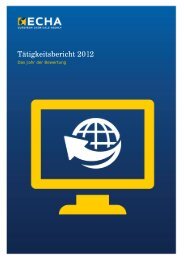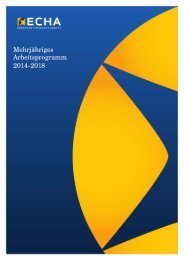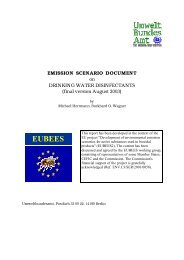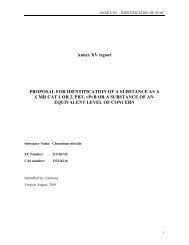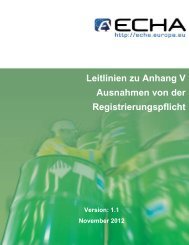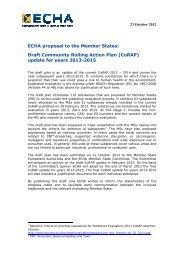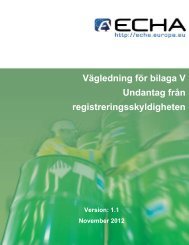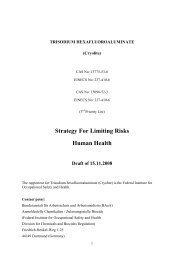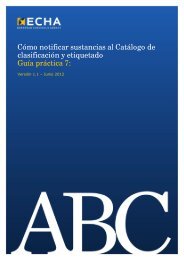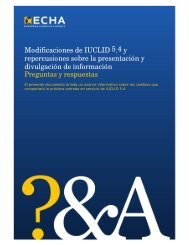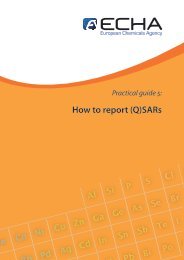Tender Specifications - ECHA - Europa
Tender Specifications - ECHA - Europa
Tender Specifications - ECHA - Europa
Create successful ePaper yourself
Turn your PDF publications into a flip-book with our unique Google optimized e-Paper software.
In principle, the data being used by the existing afore mentioned systems, are currently largely<br />
organised based on the needs of the specific systems storing the information locally and not<br />
always providing ways to access it outside of their scope. However, the data hosted by the<br />
systems are interrelated in many ways and it should be possible to query and retrieve these data<br />
based on the internal relationships they possess within the REACH regulation. This process<br />
supposes the integration of data into a single “Enterprise Data Model” proposing a structure<br />
reflecting the main components used by the REACH regulation as well as their interaction.<br />
To address this need, the Agency (in parallel to the ongoing work for supporting and/or enhancing<br />
the systems described in the previous paragraphs) has started the <strong>ECHA</strong> Data Integration project,<br />
whose objectives include:<br />
• The definition and implementation of a new Enterprise Data Model (to address the issue<br />
described above)<br />
• The definition and implementation of a Service Oriented Architecture (SOA) to provide an<br />
environment where data and functionalities are shared between systems.<br />
This work will imply the revision of the afore mentioned systems in order to align their respective<br />
data models to the consolidated enterprise data model, including possible restructuring of their own<br />
data models and enhancing them to what is envisioned to be “the next generation” of these<br />
systems.<br />
For each lot. the services to be provided by the Contractor will also cover the enhancements to<br />
move the systems (included in each lot) to this next generation.<br />
4.2.3 Overview of current infrastructure situation<br />
An indicative list of currently used products and infrastructure in the Agency is described<br />
hereafter 23 . This list is not exhaustive and may evolve over time.<br />
• Desktop-PC’s and Laptops: Microsoft Windows XP with Office 2003<br />
• some Apple/Mac systems<br />
• LAN: Cisco network equipment<br />
• Perimeter defence: corporate-class firewall & reverse-proxy, IDS and<br />
VPN-systems<br />
• Servers (Intel x86) with Microsoft Windows 2003 & 2008<br />
• Servers (Intel x86): VMware ESX versions 3.5+4.0 running Windows 2003 & 2008<br />
• Servers (Intel x86): VMware ESX running Linux (RedHat-EL, Ubuntu), Solaris 10<br />
• Servers (SPARC): Solaris 10 on Sun Microsystems hardware<br />
• SAN: Fibre Channel-based EMC CX4 SAN disk array systems<br />
• SAN: Brocade 4100 and 5300 SAN switches<br />
The present software infrastructure at the Agency includes:<br />
• Messaging & Calendar: Microsoft Exchange 2007<br />
• Microsoft Active Directory, with FIM in preparation<br />
• Domain Controllers with DNS<br />
• DHCP<br />
• Ticket-system: BMC Remedy<br />
• Databases: Oracle 10g & 11g<br />
• Databases: Microsoft SQL-server 2005, 2008, 2008r2<br />
• Data warehouse: Oracle Warehouse Builder 11g<br />
• Front-office: MS Office 2003, MS Outlook 2003, MS Internet Explorer, Firefox<br />
• Document, content management and workflows based on MOSS 2007<br />
23 Whenever a specific product name or trademark is mentioned and a sufficiently precise and fully intelligible description<br />
is not possible, such mention should be understood as referring to that product or its equivalent<br />
46



